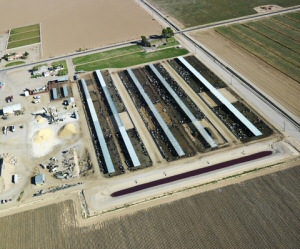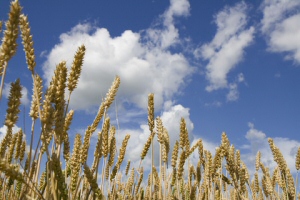Famine
 "The American fast-food diet and the meat-eating habits of the wealthy
around the world support a world food system that diverts food resources
from the hungry."
"The American fast-food diet and the meat-eating habits of the wealthy
around the world support a world food system that diverts food resources
from the hungry."
~Dr. Waldo Bello, executive director of the Institute for Food and
Development Policy
There are more than 840 million people in the world
struggling for food and going hungry right now. The World Health
Organisation calls malnutrition "the silent emergency", and says it is a
factor in at least half the 10.4 million child deaths which occur every
year.
The problem
There is more than enough food being produced to feed everyone in the
world twice over. The problem is, our meat-based
diet means that land, water, and other resources that could be used to grow
food for human beings are being used to grow
 crops for farmed animals instead. According to a report by Compassion in
World Farming, "Currently,
one third of the world's cereal crop goes to feed the 60 billion farm
animals
reared every year to produce meat, eggs and dairy products - the majority of
them on factory farms."
crops for farmed animals instead. According to a report by Compassion in
World Farming, "Currently,
one third of the world's cereal crop goes to feed the 60 billion farm
animals
reared every year to produce meat, eggs and dairy products - the majority of
them on factory farms."
People in developing countries starve next to fields of food destined for
export to more affluent countries, to be used to feed livestock. While
millions die, one third of the world's grain production is fed to farmed
animals in developed countries. In order to meet the huge demand for meat
and dairy, billions of animals are kept in confinement on factory farms, in
cramped, filthy conditions. Not allowed to feed outdoors naturally, they are
fed grain, soya, oil seeds, and fish meal. The high quality land used to
grow soy to feed animals could be used instead to grow crops for human
consumption.
In 1984, when thousands of Ethiopians were dying weekly from famine,
their rulers continued
growing and shipping millions of dollars worth of livestock grains to the UK
and other European nations. The growing consumption of meat, poultry and
dairy products has created an explosion in livestock populations worldwide.
In fact, livestock now outnumbers humans by almost three to one. In the last
40 years, the number of cattle has doubled and the fowl population has
trebled.
The meat and dairy industry is also putting a huge strain on our water
supply. It was stated during World Water Week that the growth in demand for
meat and dairy products is unsustainable. Animals need much more water than
grain to produce the same amount of food, and ending malnutrition and
feeding even more mouths will take still more water.
"Starvation does not occur because of a world food shortage. If
everyone ate a vegetarian diet, or better still, a vegan diet there would be
enough food for everyone. The only sane way forward is to grow food for
humans rather than to feed it to farmed animals." ~Jeremy Rifkin
The solution
When world leaders met at the United Nations' Food and Agriculture
Organization summit in Rome, they vowed to
halve global hunger by 2015 and discussed strategies to boost agricultural
production, which must be doubled
by 2030 to meet rising demands. But no one proposed a convincing way to
alleviate world hunger.
Dr. Walt Willett, professor of medicine at Harvard University and author
of Eat, Drink and Weigh Less, offers this simple solution: "If we changed
the way we ate, modifying what we eat, we could practically end the global
food crisis, since eating more crops and much less red meat would free up
resources to feed the world."
It would take just 40 million tons of food to eliminate the most extreme
cases of world hunger. Yet
a staggering 760 million tons of grain will be used to feed farmed animals
this
 year (compared to 100 million tons used to produce fuel). The demand for
meat is rising continually and has been especially dramatic in developing
countries. "China's meat consumption is increasing rapidly with income
growth and urbanization, and it has more than doubled in the past
generation," says Rosamond Naylor, an associate professor of economics at
Stanford University. As a result, land
once used to provide grains for humans now provides feed for chickens and
pigs.
year (compared to 100 million tons used to produce fuel). The demand for
meat is rising continually and has been especially dramatic in developing
countries. "China's meat consumption is increasing rapidly with income
growth and urbanization, and it has more than doubled in the past
generation," says Rosamond Naylor, an associate professor of economics at
Stanford University. As a result, land
once used to provide grains for humans now provides feed for chickens and
pigs.
It may seem fantastical to the average person that reducing their
individual meat intake could have an
impact on such a huge global problem as world famine but changing the way we
eat really can make a difference. According to the aid group Vegfam, a
ten-acre farm can support 60 people growing soybeans, 24 people growing
wheat, ten people growing corn and only two people producing cattle.
Reducing meat production by just ten percent in the U.S. would free enough
grain to feed 60 million people, estimates Harvard nutritionist Jean Mayer.
Sixty million people - that's the population of Great Britain, which, by the
way, could support 250 million people on an all-vegetable diet.
Facts
- It takes up to 16 pounds of grain to produce just 1 pound of edible
animal flesh, making meat consumption a very inefficient use of grain.
- About 20 percent of the world's population, or 1.4 billion people, could
be fed with the grain and soybeans fed to U.S. cattle alone.
- If everyone on Earth received 25 percent of his or her calories from
animal products, only 3.2 billion people could be nourished.

- Because the industrial world is exporting grain to developing countries
and importing the meat that is produced with it, farmers who are trying to
feed themselves are being driven off their land.
- In the US, 64% of cropland produces feed for animals, while only 2%
grows fruit and vegetables.
- It takes about 300 gallons of water per day to produce food for a vegan,
and more than 4,000 gallons of water per day to produce food for a
meat-eater.
- You save more water by not eating a pound of beef than you do by not
showering for an entire year.
- Food for a vegan can be produced on only 1/6 of an acre of land, while
it takes 3 1/4 acres of land to produce food for a meat-eater.
Conclusion
Livestock farming uses up agricultural land, water and other resources that
could far more
efficiently be utilised for growing food for people to eat directly. Quite
simply, the world needs to change its
consumption patterns if it has any realistic hope of feeding itself and the
most
sustainable way of doing that is for people to adopt a vegan diet.

References
viva.org.uk/feed-the-world
news.bbc.co.uk
www.goveg.com
www.guardian.co.uk
www.all-creatures.org
chicvegan.com
www.guardian.co.uk
www.converge.org.nz/pirm/ofow.htm